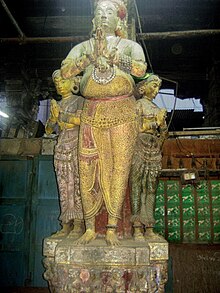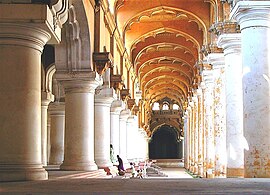Thirumalai Nayak
| Mannar Thirumalai Nayakkar | |
|---|---|
| Great King of Madurai Nayak Dynasty 7th king of Madurai Nayak Kingdom |
|

|
|
| Reign | A.D 1623–1659 |
| Coronation | Madurai nayakar dynasty |
| Predecessor | Muttu Virappa Nayak |
| Successor | Muttu Veerappa Nayak |
| Born | Madurai |
| Died |
Circa 1659 Madurai, present-day Tamil Nadu, India |
| House | Madurai Nayaks |
| Father | Muttu Krishnappa Nayak |
| Kings and Queen Regents of Madurai Nayak Dynasty |
|
|---|---|
| Part of History of Tamil Nadu | |
 |
|
| Madurai Nayak rulers | |
| Viswanatha Nayak | 1529–1563 |
| Kumara Krishnappa Nayak | 1563–1573 |
| Joint Rulers Group I | 1573–1595 |
| Joint Rulers Group II | 1595–1602 |
| Muttu Krishnappa Nayak | 1602–1609 |
| Muttu Virappa Nayak | 1609–1623 |
| Tirumalai Nayak | 1623–1659 |
| Muthu Alakadri Nayak | 1659–1662 |
| Chokkanatha Nayak | 1662–1682 |
| Rangakrishna Muthu Virappa Nayak | 1682–1689 |
| Rani Mangammal‡ | 1689–1704 |
| Vijaya Ranga Chokkanatha Nayak | 1704–1731 |
| Queen Meenakshi‡ | 1731–1736 |
| ‡ Regent Queens | |
| Capitals | |
| Madurai | 1529–1616 |
| Tiruchirapalli | 1616–1634 |
| Madurai | 1634–1665 |
| Tiruchirapalli | 1665–1736 |
| Major forts | |
| Madurai 72 Bastion Fort | |
| Tiruchirapalli Rock Fort | |
| Dindigul Fort | |
| Thirunelvelli Fort | |
| other Military forts | |
| Namakkal Fort | |
| Sankagiri Fort | |
| Attur Fort | |
| Palaces | |
| Thirumalai Nayak Mahal, Madurai | |
| Chokkanatha Nayak Palace a.k.a. Durbar Hall, Tiruchirapalli | |
| Rani Mangammal Tamukkam palace Madurai | |
Thirumalai Nayak (well known as - Thirumalai Nayakkar) ruled Madurai between A.D 1623 and 1659. He was the most notable of the thirteen Madurai Nayak rulers in the 17th century. His contributions are found in the many splendid buildings and temples of Madurai. His kingdom was under constant threat from the armies of Bijapur Sultanate and the other neighbouring Muslim kingdoms, which he managed to repulse successfully. His territories comprised much of the old Pandya territories which included Coimbatore, Tirunelveli, Madurai districts, Aragalur in southern Tamil Nadu and some territories of the Travancore kingdom.
Thirumalai Nayak was a great patron of art and architecture and the Dravidian architecture evolved into the Madurai style. He rebuilt and renovated a number of old temples of the Pandya period. His palace, known as the Thirumalai Nayak Palace, is a notable architectural masterpiece.
Thirumalai Nayak succeeded his brother Muttu Virappa Nayak on the Madurai there in A.D 1623. The political situation in south Tamil Nadu was confused with the decline of the Vijayanagar empire, and the once feudatory Nayak governors of Madurai, Thanjavur, Gingee and Mysore were quarrelling to divide the dissolving Vijayanagara Empire. The Muslim kingdoms in the Deccan began to press southwards. Immediately after becoming king, Thirumalai Nayak withheld the payment of tributes to the Vijayanargara kings. He also gathered a large army in Thiruchirapalli and strengthened its fortifications.
Around 1638, the Vijayanagara King Ranga, succeeded to the throne of Chandragiri and he soon resolved to put an end to the independence of Thirumalai and prepared to march southwards. Thirumalai had meanwhile persuaded the Vijayanagar governors of Tanjore and Gingee (in south Arcot) to join him in his defiance of their mutual suzerain, and thus Ranga was left with only Mysore, of all his feudatories, to support him. The Nayak governor of Thanjavur eventually left his allies, sent in his submission, and betrayed the other Nayaks.
...
Wikipedia
